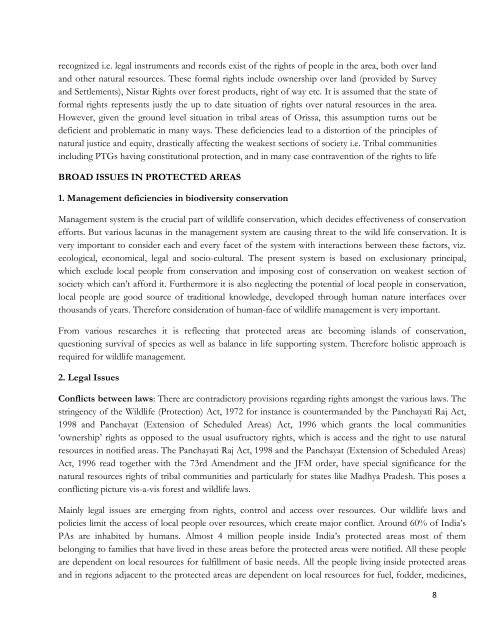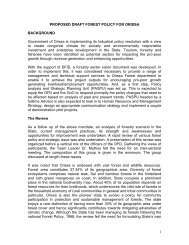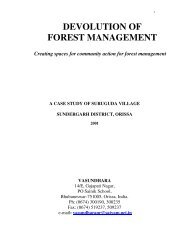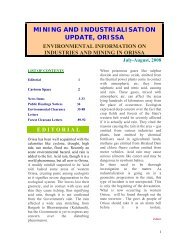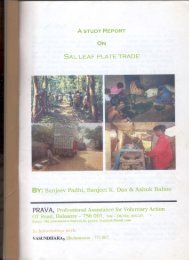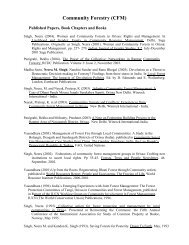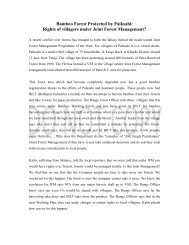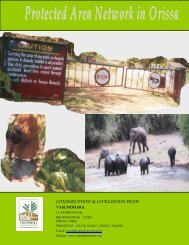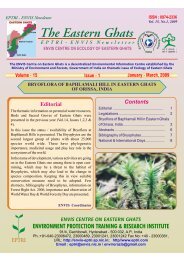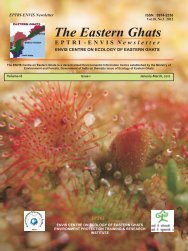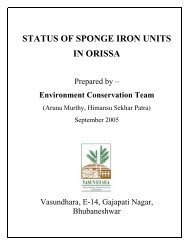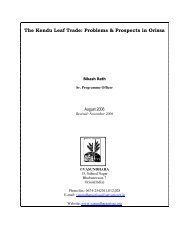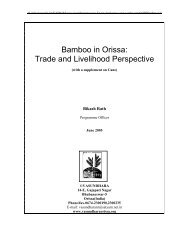Impact of NTFP ban on the lives and livelihood of the ... - Vasundhara
Impact of NTFP ban on the lives and livelihood of the ... - Vasundhara
Impact of NTFP ban on the lives and livelihood of the ... - Vasundhara
You also want an ePaper? Increase the reach of your titles
YUMPU automatically turns print PDFs into web optimized ePapers that Google loves.
ecognized i.e. legal instruments <strong>and</strong> records exist <str<strong>on</strong>g>of</str<strong>on</strong>g> <strong>the</strong> rights <str<strong>on</strong>g>of</str<strong>on</strong>g> people in <strong>the</strong> area, both over l<strong>and</strong><strong>and</strong> o<strong>the</strong>r natural resources. These formal rights include ownership over l<strong>and</strong> (provided by Survey<strong>and</strong> Settlements), Nistar Rights over forest products, right <str<strong>on</strong>g>of</str<strong>on</strong>g> way etc. It is assumed that <strong>the</strong> state <str<strong>on</strong>g>of</str<strong>on</strong>g>formal rights represents justly <strong>the</strong> up to date situati<strong>on</strong> <str<strong>on</strong>g>of</str<strong>on</strong>g> rights over natural resources in <strong>the</strong> area.However, given <strong>the</strong> ground level situati<strong>on</strong> in tribal areas <str<strong>on</strong>g>of</str<strong>on</strong>g> Orissa, this assumpti<strong>on</strong> turns out bedeficient <strong>and</strong> problematic in many ways. These deficiencies lead to a distorti<strong>on</strong> <str<strong>on</strong>g>of</str<strong>on</strong>g> <strong>the</strong> principles <str<strong>on</strong>g>of</str<strong>on</strong>g>natural justice <strong>and</strong> equity, drastically affecting <strong>the</strong> weakest secti<strong>on</strong>s <str<strong>on</strong>g>of</str<strong>on</strong>g> society i.e. Tribal communitiesincluding PTGs having c<strong>on</strong>stituti<strong>on</strong>al protecti<strong>on</strong>, <strong>and</strong> in many case c<strong>on</strong>traventi<strong>on</strong> <str<strong>on</strong>g>of</str<strong>on</strong>g> <strong>the</strong> rights to lifeBROAD ISSUES IN PROTECTED AREAS1. Management deficiencies in biodiversity c<strong>on</strong>servati<strong>on</strong>Management system is <strong>the</strong> crucial part <str<strong>on</strong>g>of</str<strong>on</strong>g> wildlife c<strong>on</strong>servati<strong>on</strong>, which decides effectiveness <str<strong>on</strong>g>of</str<strong>on</strong>g> c<strong>on</strong>servati<strong>on</strong>efforts. But various lacunas in <strong>the</strong> management system are causing threat to <strong>the</strong> wild life c<strong>on</strong>servati<strong>on</strong>. It isvery important to c<strong>on</strong>sider each <strong>and</strong> every facet <str<strong>on</strong>g>of</str<strong>on</strong>g> <strong>the</strong> system with interacti<strong>on</strong>s between <strong>the</strong>se factors, viz.ecological, ec<strong>on</strong>omical, legal <strong>and</strong> socio-cultural. The present system is based <strong>on</strong> exclusi<strong>on</strong>ary principal,which exclude local people from c<strong>on</strong>servati<strong>on</strong> <strong>and</strong> imposing cost <str<strong>on</strong>g>of</str<strong>on</strong>g> c<strong>on</strong>servati<strong>on</strong> <strong>on</strong> weakest secti<strong>on</strong> <str<strong>on</strong>g>of</str<strong>on</strong>g>society which can’t afford it. Fur<strong>the</strong>rmore it is also neglecting <strong>the</strong> potential <str<strong>on</strong>g>of</str<strong>on</strong>g> local people in c<strong>on</strong>servati<strong>on</strong>,local people are good source <str<strong>on</strong>g>of</str<strong>on</strong>g> traditi<strong>on</strong>al knowledge, developed through human nature interfaces overthous<strong>and</strong>s <str<strong>on</strong>g>of</str<strong>on</strong>g> years. Therefore c<strong>on</strong>siderati<strong>on</strong> <str<strong>on</strong>g>of</str<strong>on</strong>g> human-face <str<strong>on</strong>g>of</str<strong>on</strong>g> wildlife management is very important.From various researches it is reflecting that protected areas are becoming isl<strong>and</strong>s <str<strong>on</strong>g>of</str<strong>on</strong>g> c<strong>on</strong>servati<strong>on</strong>,questi<strong>on</strong>ing survival <str<strong>on</strong>g>of</str<strong>on</strong>g> species as well as balance in life supporting system. Therefore holistic approach isrequired for wildlife management.2. Legal IssuesC<strong>on</strong>flicts between laws: There are c<strong>on</strong>tradictory provisi<strong>on</strong>s regarding rights am<strong>on</strong>gst <strong>the</strong> various laws. Thestringency <str<strong>on</strong>g>of</str<strong>on</strong>g> <strong>the</strong> Wildlife (Protecti<strong>on</strong>) Act, 1972 for instance is counterm<strong>and</strong>ed by <strong>the</strong> Panchayati Raj Act,1998 <strong>and</strong> Panchayat (Extensi<strong>on</strong> <str<strong>on</strong>g>of</str<strong>on</strong>g> Scheduled Areas) Act, 1996 which grants <strong>the</strong> local communities‘ownership’ rights as opposed to <strong>the</strong> usual usufructory rights, which is access <strong>and</strong> <strong>the</strong> right to use naturalresources in notified areas. The Panchayati Raj Act, 1998 <strong>and</strong> <strong>the</strong> Panchayat (Extensi<strong>on</strong> <str<strong>on</strong>g>of</str<strong>on</strong>g> Scheduled Areas)Act, 1996 read toge<strong>the</strong>r with <strong>the</strong> 73rd Amendment <strong>and</strong> <strong>the</strong> JFM order, have special significance for <strong>the</strong>natural resources rights <str<strong>on</strong>g>of</str<strong>on</strong>g> tribal communities <strong>and</strong> particularly for states like Madhya Pradesh. This poses ac<strong>on</strong>flicting picture vis-a-vis forest <strong>and</strong> wildlife laws.Mainly legal issues are emerging from rights, c<strong>on</strong>trol <strong>and</strong> access over resources. Our wildlife laws <strong>and</strong>policies limit <strong>the</strong> access <str<strong>on</strong>g>of</str<strong>on</strong>g> local people over resources, which create major c<strong>on</strong>flict. Around 60% <str<strong>on</strong>g>of</str<strong>on</strong>g> India’sPAs are inhabited by humans. Almost 4 milli<strong>on</strong> people inside India’s protected areas most <str<strong>on</strong>g>of</str<strong>on</strong>g> <strong>the</strong>mbel<strong>on</strong>ging to families that have lived in <strong>the</strong>se areas before <strong>the</strong> protected areas were notified. All <strong>the</strong>se peopleare dependent <strong>on</strong> local resources for fulfillment <str<strong>on</strong>g>of</str<strong>on</strong>g> basic needs. All <strong>the</strong> people living inside protected areas<strong>and</strong> in regi<strong>on</strong>s adjacent to <strong>the</strong> protected areas are dependent <strong>on</strong> local resources for fuel, fodder, medicines,8


